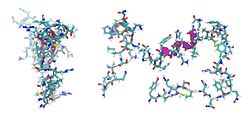Adrenomedullin
| Adrenomedullin | ||
|---|---|---|

|
||
| Rod model of human adrenomedullin (lateral, frontal), according to PDB 2L7S | ||
| Properties of human protein | ||
| Mass / length primary structure | 58 amino acids | |
| Precursor | Pro-ADM (185 AS) | |
| Identifier | ||
| Gene name | ADM | |
| External IDs | ||
| Occurrence | ||
| Parent taxon | Vertebrates | |
Adrenomedullin (ADM, from adrenal medulla, where it was first found) is a peptide that was discovered in 1993. The human ADM gene is located on chromosome 11 and codes for the precursor protein Pro-ADM with 185 amino acids, from which ADM and PAMP are formed through post-translational modification . The ADM peptide consists of 52 amino acids and is very similar to CGRP (calcitonin gene related peptide) and amylin .
Adrenomedullin is produced in the adrenal medulla , in the kidneys and lungs, and in the insufficient heart. It has a vasodilatory effect and affects several systems such as circulation, heart, hormone secretion and breathing.
Individual evidence
- ↑ InterPro : IPR001710 (English)
- ↑ M. Jougasaki, RJ Rodeheffer et al. a .: Cardiac secretion of adrenomedullin in human heart failure. In: The Journal of clinical investigation. Volume 97, Number 10, May 1996, pp. 2370-2376. doi : 10.1172 / JCI118680 . PMID 8636418 . PMC 507318 (free full text).